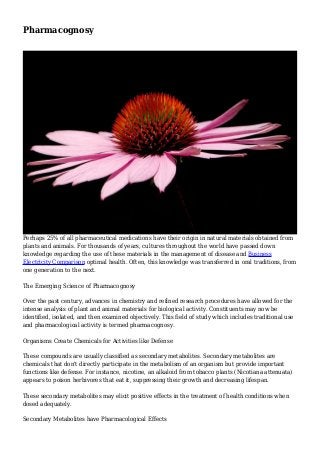
Pharmacognosy
- 1. Pharmacognosy Perhaps 25% of all pharmaceutical medications have their origin in natural materials obtained from plants and animals. For thousands of years, cultures throughout the world have passed down knowledge regarding the use of these materials in the management of disease and Business Electricity Comparison optimal health. Often, this knowledge was transferred in oral traditions, from one generation to the next. The Emerging Science of Pharmacognosy Over the past century, advances in chemistry and refined research procedures have allowed for the intense analysis of plant and animal materials for biological activity. Constituents may now be identified, isolated, and then examined objectively. This field of study which includes traditional use and pharmacological activity is termed pharmacognosy. Organisms Create Chemicals for Activities like Defense These compounds are usually classified as secondary metabolites. Secondary metabolites are chemicals that don't directly participate in the metabolism of an organism but provide important functions like defense. For instance, nicotine, an alkaloid from tobacco plants (Nicotiana attenuata) appears to poison herbivores that eat it, suppressing their growth and decreasing lifespan. These secondary metabolites may elicit positive effects in the treatment of health conditions when dosed adequately. Secondary Metabolites have Pharmacological Effects
- 2. Secondary metabolites from plants and animals often have diverse effects on other living organisms. Some examples include: Hypericin: anthroquinone derivative of St John's Wort (Hypericum perforatum), immunity and mood enhancement Echinacoside: phenylethanoid found in various Echinacea species, immune enhancement Azadirachtin: tetratriterpenoid derivative of neem (Azadirachta indica), inhibits feeding of various insects Digoxin: cardiac glycoside of foxglove (Digitalis purpurea), regulates rhythm and strengthens beat of heart Exendin-4: a hormone-like protein derived from Gila monster (Heloderma suspectum) saliva, hypoglycemic effects Isolated Compounds verses Crude Materials Crude materials are a complex mix of chemical compounds with varying and often synergistic effects. Controversy exists regarding the use of isolated compounds verses crude forms of materials. Proponents of isolated constituents often speak on the varying potency and relative scarcity of plants and animals. Other complexities impacting the use crude materials include adulteration, use of wrong species, and improper harvesting procedures. Isolated compounds often may be mass produced using organisms or laboratory methods. Opponents of isolated constituents point to the increased chance of adverse effects when using isolated compounds, and the synergistic effects associated with the soup of constituents in crude materials. Sources: Bond, "Exenatide (Byetta) as a novel treatment option for type 2 diabetes mellitus," Baylor University Medical Center Proceedings 19, no. 3 (July 2006): 281-4. Brockman, H. et al. 1939 Hypericin, the photodynamically active pigment from Hypericum perforatum. Naturwiss.27:550-555
- 3. Edith Beckmann Gemma E. Veitch and Gemma E. Veitch, Edith Beckmann, Brenda J. Burke, Alistair Boyer, Sarah L. Maslen, Steven V. Ley, "Synthesis of Azadirachtin: A Long but Successful Journey," Angewandte Chemie International Edition 46 (2007): 7629. Goodman, RM Rossen, DS Cannom, AK Rider and DC Harrison, "Effect of digoxin on atioventricular conduction." Circulation 1975;51;251-256 Yu Wu et al., "Protective effects of echinacoside on carbon tetrachloride-induced hepatotoxicity in rats," Toxicology 232, no. 1-2 (March 22, 2007): 50-56. About the author James Pendleton Dr. James Pendleton: Primary Care / Expert Supplement Design Popular stories Varuna and Kidney Stones Thuja: Beyond Homeopathy with this Immune-Stimulating Herb Health Impact of High Fructose Corn Syrup